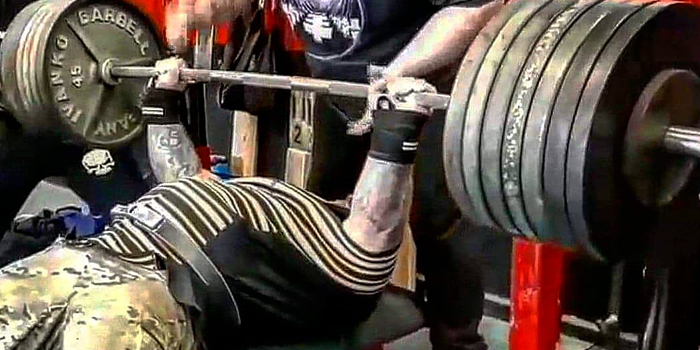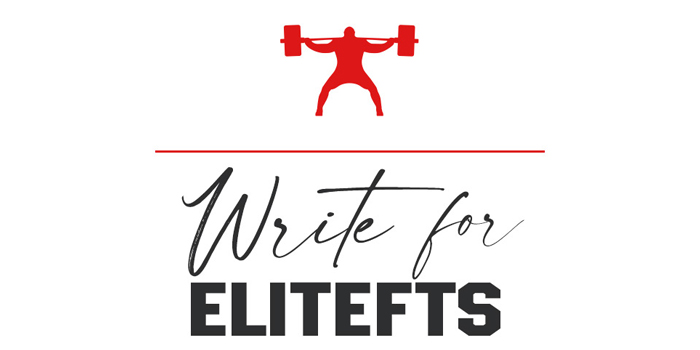
First off, I am one hundred percent sure this article will make a lot of shirted board pressers angry. But for those of you that want to learn, hear me out. I will state my case why and how shirted board presses destroyed my bench press and what I did to correct it, and I will even back it up with the help of Mr. Louie Simmons.
Shirted Board Press
Prior to getting into doing shirted board presses, exclusively and as programmed by my coach, I had benched 672.5 pounds in a 2-ply SDP in 2014 at Canadian Nationals and a near miss at 705 pounds. From here, whenever I benched in my shirt - generally every four to six weeks - it was always to boards, mostly a 2-board. Things went fantastic in training; I was handling weights in the mid to high 700s, always to boards. Things were great and we expected a big bench at the next competition.
However, at the next meet, I bombed on the bench. Then, the next meet after that, I bombed again. At the third meet, I had literally lost over 100 pounds on the bench press and narrowly squeezed out a meager 560 pounds, giving me a sub-par total coupled with the 1,000-pound squat I did at that meet. I was devastated and desperate to fix what was wrong. Unfortunately, I found that trusting blindly in my coach for years did me more harm than good. I should have been learning on my own, and thinking for myself as well, not just relying on a coach entirely. Blindly following others will come to bite me in the ass once again later on, too.
On the drive home from that meet, I made some calls and decided I needed to take action, even if it ended up costing me a friendship and coach, which unfortunately, it did. I got myself invited to Adirondack Barbell Club in Glens Falls, NY to fix my bench, hands-on, with bench technician Bill Crawford. I drove there every two weeks, or sometimes every week, from Canada, for Friday night training and sometimes even slept in the gym.
No More Shirted Board Press
Bill immediately made two huge changes in my training. Upon seeing my bench, he asked how my shoulders felt, and I replied, “Beat up!” He had me stop the weekly Dynamic Effort (DE) bench press altogether and replace it with strict heavy lockout work. This included rack lockouts and raw-only board presses (done the Metal Militia way), tons of tricep work plus accessories, stating that I was one step away from a shoulder injury from the constant DE bench work every week, and he was right. Turns out all the benching was way too much work for my body to recover from and was holding me back big time. Secondly, I NEVER did shirted board presses EVER again. No one in his gym does, and I will explain why in a moment.
Crawford also corrected my bar path and made it so I could touch 315 pounds for triples in my competition Super Duper Phenom (SDP), which was a grid stitched 3-ply shirt, at the time. Some people tell me this is totally impossible. No, it is not, I did it. With the right teaching, coaching, and perseverance and putting in some actual hard work, instead of just doing half-range board presses and hoping like hell I could bench something on a meet day, I did it.
And let me tell you, when you no longer worry about touching in competition; when your body has a plan and a certain bar path on the descent, when you know the trick to touching easily, your bench will improve substantially. What I see a lot in competitions lately is people that have zero idea how to touch and they are just flying on a wing and a prayer to get it to their chest. I have also heard the excuse that the new SDPs will not stand up to that much touching. Well buddy, then it is time to get a different type of shirt if they can not stand up, and stop making excuses.
Why Shirted Board Presses Failed Me
Now, let’s dig into the why of my failure. First, lifters love board presses in a shirt. WHY? Because it is very easy and not overly mentally taxing, you get to move a bunch of big weight for your Instagram post, and you feel like you are accomplishing something. But you are likely not, and herein lies the big problem. Here is where Mr. Louie Simmons helps us to understand the WHY. Three words, “TIME UNDER TENSION.”
A competition bench press takes a certain amount of time to complete. We train ourselves, by doing full bench presses in training, to be able to hold, handle, lower and press said weight, for said amount of time, plus holding the bar for extended periods at lockout, before and after the press, and doing the triples. If you take longer to complete the lift, for whatever reason, your chances of a successful lift decrease immensely. You should condition yourself with time under tension to help decrease your chance of failing a rep and allow yourself to grind out the attempt.
RECENT: What to Do With Your Head in the Deadlift
So, here we are in training, always taking shirted attempts to 1-, 2-, or 3-boards, and you are feeling fantastic leading into the meet because someone told you whatever you bench to a 2-board will be there meet day. Well, I am here to tell you, it most likely WILL NOT. This thinking is like a runner training for the 500-yard dash, but only running 400 yards in training, and hoping the last 100 yards will be there meet day. With the boards in a shirt, in training, you are programming yourself for a shorter time under tension.
So, for example, your 2-board press takes five to six seconds in training. Your full-range bench in the competition takes 10 plus seconds. You just shorted yourself four to five seconds of time under tension training. When you get to competition day, your body will not likely be prepared to handle the weight for that extra time, and your chances of failure increase exponentially. This is why we frequently now see lifters bombing on the bench or struggling to get just one attempt in. And I know first hand, I did exactly that. I see some big-name lifters with well over 1,000 pound squats, unable to get low or mid 600 pound benches in, which to me would be quite embarrassing.
Bench Press Gains
So now you will say, “So and so does board presses in a shirt exclusively and they are the best in the world.” Lifters would do well to realize that 99 percent of us are not extremely gifted super athletes like these lifters, who could literally do just about anything in training and still come out on top; it is genetics. Yes, shirted board presses have and will work for certain individuals. If you are one of these gifted individuals, good for you. Keep doing what you are doing, and count yourself lucky. You have the super ability to adapt and overcome in real-time.
However, if you are doing this and you are not making the bench gains you think you should be, drop the boards for a training cycle, learn how to touch and hit triples with sub-maximal weight, and see how much you improve on your competition bench. I am willing to bet it will be substantial. You can make those gains, you just need to work harder, adapt and overcome them ahead of the day you need to perform on the platform.
My Results
To follow up on my own results, after dropping shirted board presses altogether, I gained my 100-plus pounds back and could break into the 700s in competition easily. Again, does shirted board work for certain talented individuals? YES! Did it work for me? CERTAINLY NOT! Will it work for you? Try and see. But chances are you are just like the rest of us, spinning your wheels with shirted board presses for no good reason and all you are gaining are Instagram views and nothing on the platform. It is definitely a hard pill to swallow for some, but the results are monumental, I promise!
Nathan Robertson is the previous owner of Amherst Powerlifting Club in Nova Scotia, Canada, and the current owner of Berserker Barbell in Saskatchewan, Canada. He competed for 25+ years in powerlifting, is an IPA Canada Chairman, and is an IPA and WPC International Judge. Nathan is one of only six 1000-pound squatters in Canada and a Top-10 overall Bencher in Canada. He is also a multiple IPA World Record Holder.











Which are your thoughts on increase the time under tension with boards adding more reps? And which is the alternative to handle those huge weights that build the CNS when training? Because I think that touching with light weight is one of the bests things you can do to improve tour technique, but you'll still need to get usted to the competition weight...
Maybe I sound a bit skeptical or like judgmental, but I just want to dug deep into all of that.
Thank you.
You can be doing much more productive things, things that actually yield results
You're still using those big weights in the shirt, I'm just saying I got so good at touching I could touch with really light weights
When you've done your opener for a triple in the gym, it's no worries on the platform
Thank you for your insights. Could you elaborate further on the program you follow in your shifted ben h training
Shirt day I broke down into 3 week waves, week one I wore 1 ply band, week two, a 2 ply band, week three was in the shirt. Triples, triples, triples, work up to a max for that day, you can float the first rep if needed, but 2nd and 3rds need to touch, or you don't move up until they do. Follow with assistance for lats, delts, pecs and triceps.
Lockout day is just that, so more triples, but in a lockout exercise, like rack lockouts, raw boards, etc also followed by assistance.